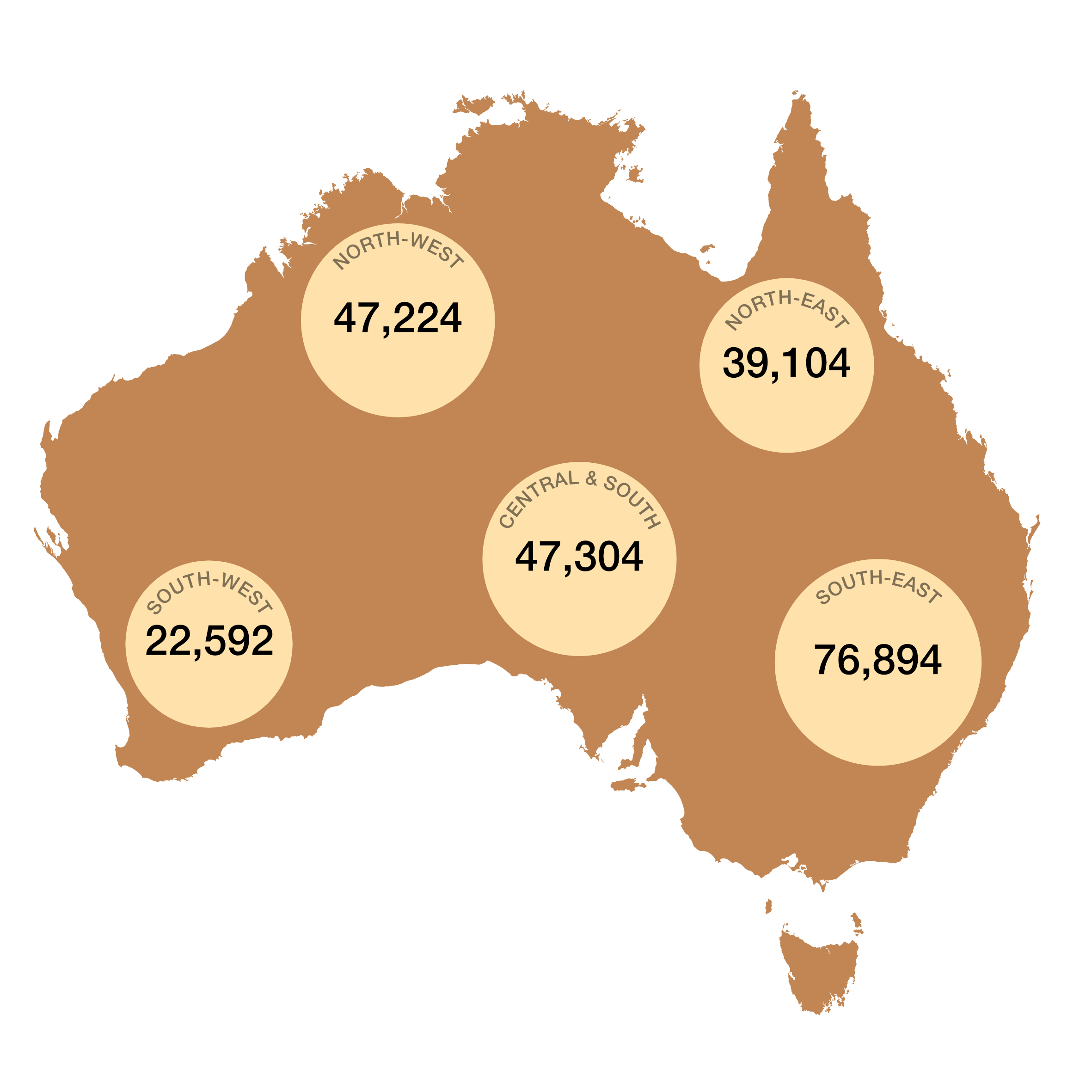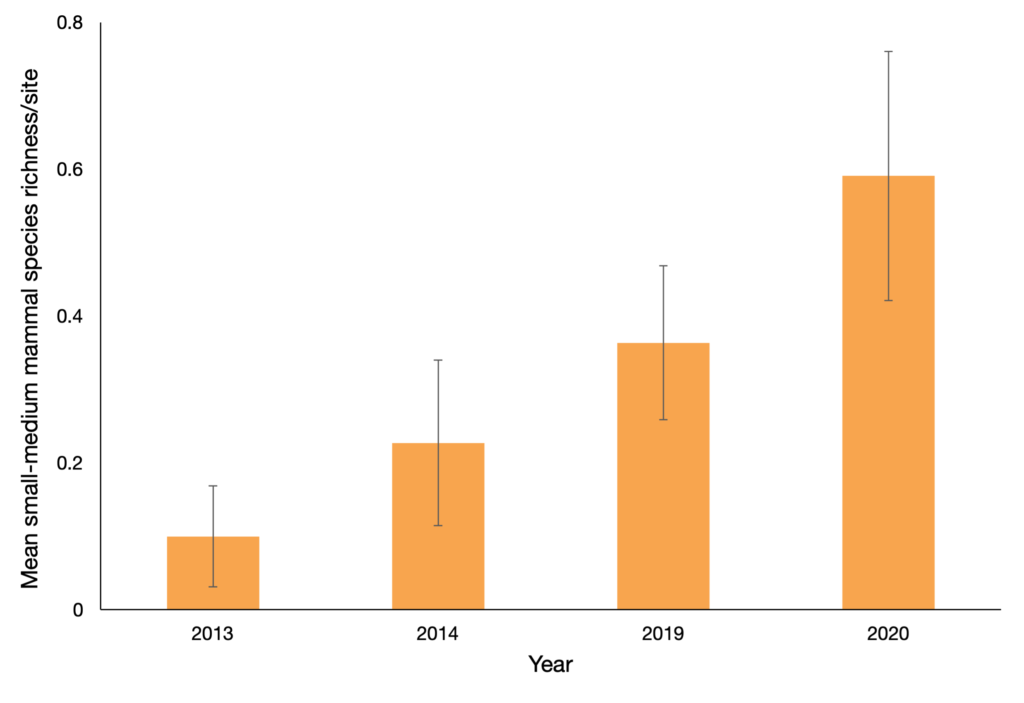By Dr Catherine Hayes, Wildlife Ecologist, Mareshell Wauchope, Senior Field Ecologist, Dr Liana Joseph, National Science Manager & Dr John Kanowski, Chief Science Officer
The results are in for the AWC Ecohealth Program 2020! Every year, we undertake a large monitoring program, known as ‘Ecohealth’, to assess the status of wildlife and threats across AWC’s sanctuaries and partnership sites. You can read more about Ecohealth in earlier editions of Wildlife Matters (in editions 37 and 41). In brief, the program involves targeted surveys of focal species, surveillance monitoring of animal assemblages (e.g., small mammals, reptiles, birds), studies of vegetation and ecological processes and the monitoring of key threats.
The Ecohealth Program is a major component of AWC’s Science Program involving a huge investment in planning, field work, data management, statistical analysis and report writing. The field work component is particularly impressive with AWC’s ecologists, interns and volunteers spending many days and nights in remote locations across the continent. In 2020, the Ecohealth Program consisted of 136 surveys across 26 properties, the total effort exceeding 230,000 trap nights (camera and live trapping) and 1,400 bird surveys, amongst other work. As an example, surveys at Buckaringa Wildlife Sanctuary in 2020 comprised 2,160 live trap nights (for small-medium mammals and reptiles), 43 kilometres of survey transects for large herbivores, 62 kilometres of survey transects for feral predators and 54 bird surveys.

A particular focus of the Ecohealth Program involves threatened species. Indicator species include animals and plants, both cryptic (e.g., the Cobar Greenhood Orchid) and ‘common’ (e.g., the Woylie), from a range of guilds including herbivores (e.g., Sharman’s Rock-wallaby) and predators (e.g., Northern Quoll).
One threatened species monitored across multiple AWC properties is the threatened Malleefowl, an ecosystem engineer that shifts large volumes of soil and leaf litter when constructing its breeding mounds. In south-west NSW, in partnership with the NSW Department of Planning Industry and Environment, AWC is managing a project funded by the NSW Government’s Saving our Species program to map Malleefowl mounds using aircraft-mounted LiDAR (laser beams). These mapped ‘mounds’ are then ground-truthed by AWC ecologists. During the latest Ecohealth surveys, 123 verified mounds were surveyed on Mallee Cliffs National Park. Of these, seven mounds were active, five of which were inside the fenced feral predator-free area – the highest number of active mounds in a decade. At Scotia, surveys of historical and new LiDAR-identified sites revealed 12 active mounds, eight of which are inside the fenced area – the highest number to date. Malleefowl are also monitored at Mt Gibson and Yookamurra Wildlife Sanctuaries. Data from these surveys highlight the value of fenced areas for Malleefowl and other ground-active birds vulnerable to introduced predators.
 Wayne Lawler/AWC
Wayne Lawler/AWC
The Ecohealth Program extends to surveillance monitoring of broad faunal groups. Small to medium-sized mammals, a group particularly vulnerable to introduced predators, are a focus of Ecohealth surveys across all AWC’s properties. Survey techniques vary with the target guild and logistical factors such as substrate. Pitfall traps (i.e., in-ground buckets) and/or box trapping are widely used, both resource-intensive survey methods, while camera traps are relied on for hard-to-reach (or ‘hard-to-dig’) locations such as remote rocky outcrops. Tracking mammal populations through time allows us to understand the status of the wildlife on the properties we manage and provides important insights into their ecology, their response to weather conditions and the impacts of AWC’s management activities.
 Brad Leue/AWC
Brad Leue/AWC
Recent Ecohealth data demonstrates how strongly small-medium mammal assemblages across Australia respond to drought and flooding rain. In the Kimberley, for example, small mammal populations declined through the severe drought of 2018–2019, with a modest recovery following a return to average conditions in 2020. At Charnley River–Artesian Range Wildlife Sanctuary small mammal abundance dropped from around five individuals to one per 100 trap nights from 2016 to 2019; while species richness fell from 1.4 to 0.6 species per site on average in that period. Both metrics improved slightly in 2020, mainly due to more mammal captures in riparian habitats, a vital refuge in dry conditions.
At AWC’s Mornington Wildlife Sanctuary, monitoring has revealed several ‘boom and bust’ cycles of small mammals since 2004. Importantly, monitoring has shown small mammal numbers are consistently higher in destocked than grazed areas, providing support for AWC’s feral herbivore management program.
Across the Kimberley, following an exceptional wet season at the start of 2021, preliminary results from current field work indicate a substantial recovery in small mammal populations. This information will be reported in AWC’s 2021 Ecohealth data.
At Bowra Wildlife Sanctuary, in south-west Queensland, surveys have documented a steadily increasing richness of small mammals. Over this period, AWC has greatly reduced grazing pressure on the sanctuary, with sustained control of feral animals and fence repairs to contain wandering stock. Rainfall also improved in 2020, after three years of drought. Both climate and land management are likely to have contributed to the recovery of small mammals on the property.

AWC also monitors fire regimes, introduced species and other threats to wildlife and their habitats. In relation to fire, we are particularly concerned about the incidence and extent of wildfires. In northern Australia, fire management strategies include prescribed burning (typically in the early dry season) and where feasible, the suppression of wildfires. On some properties, ‘storm burns’ (i.e., fires lit after the first rains) are used to manage woody thickening. On one of our northern properties, Piccaninny Plains Wildlife Sanctuary in Far North = Queensland, results for 2020 show all key fire metrics have improved since AWC management. In the decade to 2009, on average 76 per cent of the property was burnt annually, mostly by ‘hot’ fires in the late dry season. In contrast, by 2020, just 44 per cent of the property was burnt, mostly by ‘cooler’ prescribed fires. This changed fire regime has helped retain ground cover and protect fire-sensitive habitats on the property.
AWC’s large investment in ecological field work enables us to understand the status of the wildlife we conserve and threats we manage. Without these data, we would have little idea of the successes or failures in conserving wildlife on our properties. Quite simply, these data – together with our research program – enable us to measure the ecological ‘return’ on our investment in conservation and determine whether our actions are effectively restoring and protecting Australia’s precious natural values.
We continue to refine the program, using new technology when available. In 2020, for example, we conducted a census of Southern Hairy-nosed Wombats at Yookamurra Wildlife Sanctuary (using Google Earth technology) for the first time. Over the last decade, AWC’s field work has become highly reliant on the use of remote cameras and we are increasingly incorporating acoustic monitors into our surveys of birds, frogs, bats and other vocalising mammals. We continue to incorporate advances in applied statistical analysis in our evaluation of monitoring data and we are working at better communicating the results of our surveys. These developments are all intended to help us robustly address the fundamental question relevant to AWC’s mission: ‘how well are we conserving Australia’s animal species and the habitats in which they live?’
Read and download the full issue of Wildlife Matters here.
Donate to help save Australia’s threatened wildlife and wild places